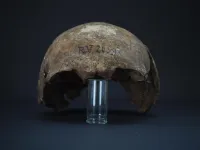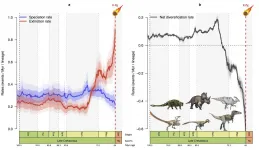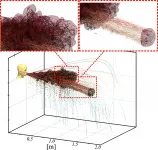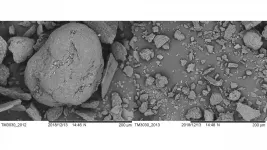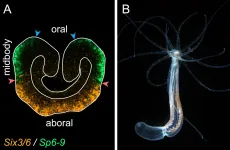Polymers in meteorites provide clues to early solar system
A group of polymers across several members of the oldest meteorite class, the CV3 type, shed light on space chemistry as early as 12.5 billion years ago
2021-06-29
(Press-News.org) WASHINGTON, June 29, 2021 -- Many meteorites, which are small pieces from asteroids, do not experience high temperatures at any point in their existence. Because of this, these meteorites provide a good record of complex chemistry present when or before our solar system was formed 4.57 billion years ago.
For this reason, researchers have examined individual amino acids in meteorites, which come in a rich variety and many of which are not in present-day organisms.
In Physics of Fluids, by AIP Publishing, researchers from Harvard University show the existence of a systematic group of amino acid polymers across several members of the oldest meteorite class, the CV3 type. The polymers form organized structures, including crystalline nanotubes and a space-filling lattice of regular diamond symmetry with density estimated to be 30 times less than water.
"Because the elements required to form our polymers were present as early as 12.5 billion years ago, and there appears to be a gas phase route to their formation, it is possible that this chemistry was and is present throughout the universe," said author Julie McGeoch.
Preventing terrestrial contamination was a top priority for the researchers. They devised a clean room method using a clean stepper motor with vacuum-brazed diamond bits to drive several millimeters into the meteorite sample before retrieving newly etched material from only the bottom of the hole. Several drill bits were used in a single etch, all being cleaned with ultrasonification.
The resulting micron scale meteorite particles were then placed in tubes and stored at minus 16 degrees Celsius. Polymers were induced to diffuse out of the micron particles via Folch extraction, which involves two chemical phases related to different solvents with different densities.
Mass spectrometry revealed the existence of the polymers, which were composed of chains of glycine, the simplest amino acid, with additional oxygen and iron. They had a very high deuterium-to-hydrogen-isotope ratio that confirmed their extraterrestrial origin.
This research was inspired by observations on a small, highly conserved biological protein that entrapped water. That finding suggested if such a molecule could form in gas phase space, it would aid early chemistry by supplying bulk water.
The researchers employed quantum chemistry to show amino acids should be able to polymerize in space within molecular clouds, retaining water of polymerization. Many experiments followed using meteorites as the source of polymer culminating in 3D structures.
Going forward, the researchers hope to get more detail of the glycine rods via continued X-ray analysis. Other polymers in the same class remain to be characterized and could reveal the energetics of polymer formation.
INFORMATION:
The article, "Structural organization of space polymers," is authored by Julie E.M. McGeoch and Malcolm W. McGeoch. The article will appear in Physics of Fluids on June 29, 2021 (DOI: 10 1063/5.0053302). After that date, it can be accessed at https://aip.scitation.org/doi/10.1063/5.0054860.
[Attachments] See images for this press release:

ELSE PRESS RELEASES FROM THIS DATE:
2021-06-29
The oldest strain of Yersinia pestis--the bacteria behind the plague that caused the Black Death, which may have killed as much as half of Europe's population in the 1300s--has been found in the remains of a 5,000-year-old hunter-gatherer. A genetic analysis publishing June 29 in the journal Cell Reports reveals that this ancient strain was likely less contagious and not as deadly as its medieval version.
"What's most astonishing is that we can push back the appearance of Y. pestis 2,000 years farther than previously published studies suggested," says senior author Ben Krause-Kyora, head of the aDNA Laboratory at the University of Kiel in Germany. ...
2021-06-29
Ten million years before the well-known asteroid impact that marked the end of the Mesozoic Era, dinosaurs were already in decline. That is the conclusion of the Franco-Anglo-Canadian team led by CNRS researcher Fabien Condamine from the Institute of Evolutionary Science of Montpellier (CNRS / IRD / University of Montpellier), which studied evolutionary trends during the Cretaceous for six major families of dinosaurs, including those of the tyrannosaurs, triceratops, and hadrosaurs. Using a novel statistical modelling method that limited bias associated with gaps in the fossil record, they demonstrated that, for dinosaurs 76 million years ...
2021-06-29
WASHINGTON, June 29, 2021 -- Computer simulations have been used with great success in recent months to visualize the spread of the COVID-19 virus in a variety of situations. In Physics of Fluids, by AIP Publishing, researchers explain how turbulence in the air can create surprising and counterintuitive behavior of exhaled droplets, potentially laden with virus.
Investigators from the University of Florida and Lebanese American University carried out detailed computer simulations to test a mathematical theory they developed previously. They found nearly identical exhalations could spread in different ...
2021-06-29
WASHINGTON, June 29, 2021 -- As pervasive as they are in everyday uses, like encryption and security, randomly generated digital numbers are seldom truly random.
So far, only bulky, relatively slow quantum random number generators (QRNGs) can achieve levels of randomness on par with the basic laws of quantum physics, but researchers are looking to make these devices faster and more portable.
In Applied Physics Letters, by AIP Publishing, scientists from China present the fastest real-time QRNG to date to make the devices quicker and more portable. The ...
2021-06-29
What The Study Did: This study describes four patients who presented with acute myocarditis after mRNA COVID-19 vaccination.
Authors: Raymond J. Kim, M.D., of the Duke Cardiovascular Magnetic Resonance Center in Durham, North Carolina, is the corresponding author.
To access the embargoed study: Visit our For The Media website at this link https://media.jamanetwork.com/
(doi:10.1001/jamacardio.2021.2828)
Editor's Note: The article includes conflict of interest disclosures. Please see the articles for additional information, including other authors, author contributions and affiliations, conflicts of interest and financial disclosures, and funding and support.
INFORMATION:
Media advisory: ...
2021-06-29
What The Study Did: Researchers describe myocarditis presenting after COVID-19 mRNA vaccination in 23 patients within the Military Health System.
Authors: Jay Montgomery, M.D., of Walter Reed National Military Medical Center in Bethesda, Maryland, and Margaret Ryan, M.D., M.P.H., of the Naval Medical Center San Diego, are the corresponding authors.
To access the embargoed study: Visit our For The Media website at this link https://media.jamanetwork.com/
(doi:10.1001/jamacardio.2021.2833)
Editor's Note: The article includes conflict of interest disclosures. Please see the articles for additional information, including other authors, author contributions and affiliations, conflicts of interest and financial disclosures, and funding ...
2021-06-29
This press release is in support of a presentation by Dr Ruth Howie presented online at the 37th Annual Meeting of ESHRE.
29 June 2021: Cancer treatments can cause premature ovarian failure (POI) including in girls who want to become mothers eventually. Ovarian tissue cryopreservation (OTC) provides a future fertility option but is invasive, has risks and evidence indicates that most girls don't develop POI. So, doctors face the dilemma of how to offer OTC appropriately.
Now, an assessment tool has been found to help predict correctly which female cancer patients aged under 18 years will develop POI and should therefore be offered OTC. Results from a long-term follow-up study of 423 girls and young women show nearly a quarter (24%; n = 9) of the 37 assessed as high ...
2021-06-29
WASHINGTON, June 29, 2021 - For more than 60 years, algae have been studied as a potential feedstock for biofuel production, but the cellulose in their cell wall makes it hard to access the critical molecules inside and convert them to biogas.
In the Journal of Renewable and Sustainable Energy, from AIP Publishing, an international research team reports their success in using urea and sodium hydroxide (NaOH, commonly known as lye or caustic soda) as a pretreatment of algae, which breaks down cellulose and more than doubles biogas production under their initial experimental conditions.
"We were ...
2021-06-29
With advances in medical science driving progress against childhood brain tumors, today three out of four young patients survive at least five years beyond diagnosis. However, the outcomes look grim when malignant cells spread, or metastasize.
Such is the case with medulloblastoma, a type of brain cancer that arises in the cerebellum, at the back of the head. Although rare in absolute terms -- about 350 cases emerge each year, 60 percent of them in children -- medulloblastoma is the most common and deadliest form of pediatric brain cancer. Metastasis ...
2021-06-29
In a new article in Nature Communications, a research group led by Grigory Genikhovich at the University of Vienna has found that the way the main body axis of sea anemones is patterned by different intensities of β-catenin signaling is similar to that of sea urchins and vertebrates. This suggests that this axial patterning mechanism already existed about 650 million years ago.
The positioning of all anatomical structures in an embryo is determined by systems of molecular coordinates, which are called body axes. Different regulatory genes are activated at specific locations along the body axes to drive the development of all body parts in correct places.
This process is very ...
LAST 30 PRESS RELEASES:
[Press-News.org] Polymers in meteorites provide clues to early solar system
A group of polymers across several members of the oldest meteorite class, the CV3 type, shed light on space chemistry as early as 12.5 billion years ago

